
Outline of the 1973 Allende Coup in Chile and Pinochet's Junta (this video under CC-BY-SA). Created by Sal Khan.
- Subject:
- History
- Material Type:
- Lesson
- Provider:
- Khan Academy
- Provider Set:
- Khan Academy
- Author:
- Sal Khan
- Date Added:
- 07/15/2021

Outline of the 1973 Allende Coup in Chile and Pinochet's Junta (this video under CC-BY-SA). Created by Sal Khan.

American Government is designed to meet the scope and sequence requirements of the single-semester American government course. This title includes innovative features designed to enhance student learning, including Insider Perspective features and a Get Connected Module that shows students how they can get engaged in the political process. The book provides an important opportunity for students to learn the core concepts of American government and understand how those concepts apply to their lives and the world around them. American Government includes updated information on the 2016 presidential election.Senior Contributing AuthorsGlen Krutz (Content Lead), University of OklahomaSylvie Waskiewicz, PhD (Lead Editor)
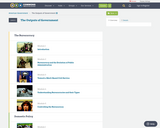
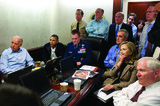
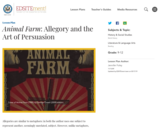
Allegories are similar to metaphors: in both the author uses one subject to represent another, seemingly unrelated, subject. However, unlike metaphors, which are generally short and contained within a few lines, an allegory extends its representation over the course of an entire story, novel, or poem. This lesson plan will introduce students to the concept of allegory by using George Orwell’s widely read novella, Animal Farm, which is available on Project Gutenberg.
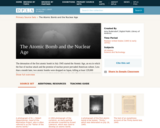
This collection uses primary sources to explore the Atomic Bomb and the Nuclear Age it started. Digital Public Library of America Primary Source Sets are designed to help students develop their critical thinking skills and draw diverse material from libraries, archives, and museums across the United States. Each set includes an overview, ten to fifteen primary sources, links to related resources, and a teaching guide. These sets were created and reviewed by the teachers on the DPLA's Education Advisory Committee.
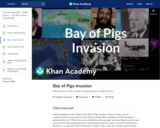
The Bay of Pigs Invasion. Created by Sal Khan.
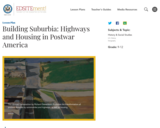
This lesson highlights the changing relationship between the city center and the suburb in the postwar decades, especially in the 1950s. Students will look at the legislation leading up to and including the Federal Highway Act of 1956. They will also examine documents about the history of Levittown, the most famous and most important of the postwar suburban planned developments.
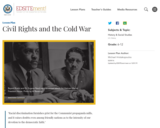
This lesson plan attempts to dissolve the artificial boundary between domestic and international affairs in the postwar period to show students how we choose to discuss history.
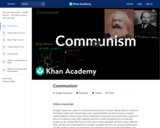
Overview of Communism and Marxist-Leninist states.
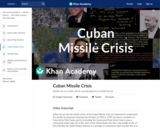
The Cuban Missile Crisis. Created by Sal Khan.
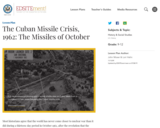
Most historians agree that the world has never come closer to nuclear war than it did during a thirteen-day period in October 1962, after the revelation that the Soviet Union had stationed several medium-range ballistic missiles in Cuba. This lesson will examine how this crisis developed, how the Kennedy administration chose to respond, and how the situation was ultimately resolved.
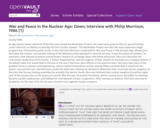
At age twenty-seven, physicist Philip Morrison joined the Manhattan Project, the code name given to the U.S. government's covert effort at Los Alamos to develop the first nuclear weapon. The Manhattan Project was also the most expensive single program ever financed by public funds. In this video segment, Morrison describes the charismatic leadership of his mentor, J. Robert Oppenheimer, and the urgency of their mission to manufacture a weapon 'which if we didn't make first would lead to the loss of the war." In the interview Morrison conducted for War and Peace in the Nuclear Age: 'Dawn,' he describes the remote, inaccessible setting of the laboratory that operated in extreme secrecy. It was this physical isolation, he maintains, that allowed scientists extraordinary freedom to exchange ideas with fellow physicists. Morrison also reflects on his wartime fears. Germany had many of the greatest minds in physics and engineering, which created tremendous anxiety among Allied scientists that it would win the atomic race and the war, and Morrison recalls the elaborate schemes he devised to determine that country's atomic progress. At the time that he was helping assemble the world's first atomic bomb, Morrison believed that nuclear weapons 'could be made part of the construction of the peace.' A month after the war, he toured Hiroshima, and for several years thereafter he testified, became a public spokesman, and lobbied for international nuclear cooperation. After leaving Los Alamos, Morrison returned to academia. For the rest of his life he was a forceful voice against nuclear weapons.
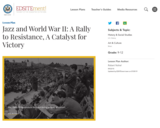
Learn about the effects that the Second World War had on jazz music as well as the contributions that jazz musicians made to the war effort. This lesson will help students explore the role of jazz in American society and the ways that jazz functioned as an export of American culture and a means of resistance to the Nazis.
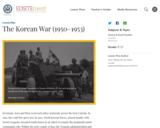
In 1950, North Korean forces, armed mainly with Soviet weapons, invaded South Korea in an effort to reunite the peninsula under communist rule. This lesson will introduce students to the conflict by having them read the most important administration documents related to it.
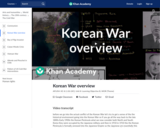
The origins and progress of the Korean War. Created by Sal Khan.
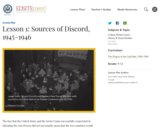
The fact that the United States and the Soviet Union successfully cooperated in defeating the Axis Powers did not necessarily mean that the two countries would continue to get along in the postwar world. This lesson will examine the U.S.-Soviet disagreements regarding Germany and Eastern Europe.

The hunt for Communists in the United States clearly reached the point of hysteria by the early 1950s, but what is often overlooked is that it had its origins in a very real phenomenon. This lesson will expose students to recently declassified FBI documents and transcripts of the Rosenberg trial. It will encourage them to think seriously about the extent of the Soviet espionage network in America, thus setting the stage for a proper understanding of later hearings by the House Un-American Activities Committee and Joseph McCarthy.
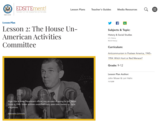
In the late 1940s and early 1950s, relations between the United States and the Soviet Union had deteriorated to the point of "cold war," while domestically the revelation that Soviet spies had infiltrated the U.S. government created a general sense of uneasiness. This lesson will examine the operations of House Un-American Activities Committee (HUAC) in the late 1940s.

The unwillingness of the Soviet Union to allow the creation of independent and democratic states in Eastern Europe, and the failure of East and West to reach a compromise on Germany, left many Americans puzzled. Why were the Soviets acting as they did? Moreover, how should the United States respond? This lesson will consider containment through the use of original documents, mostly from the Truman Presidential Library. They will study what it meant in theory, and then examine the first two major instances of its application"”the Truman Doctrine and the Marshall Plan.